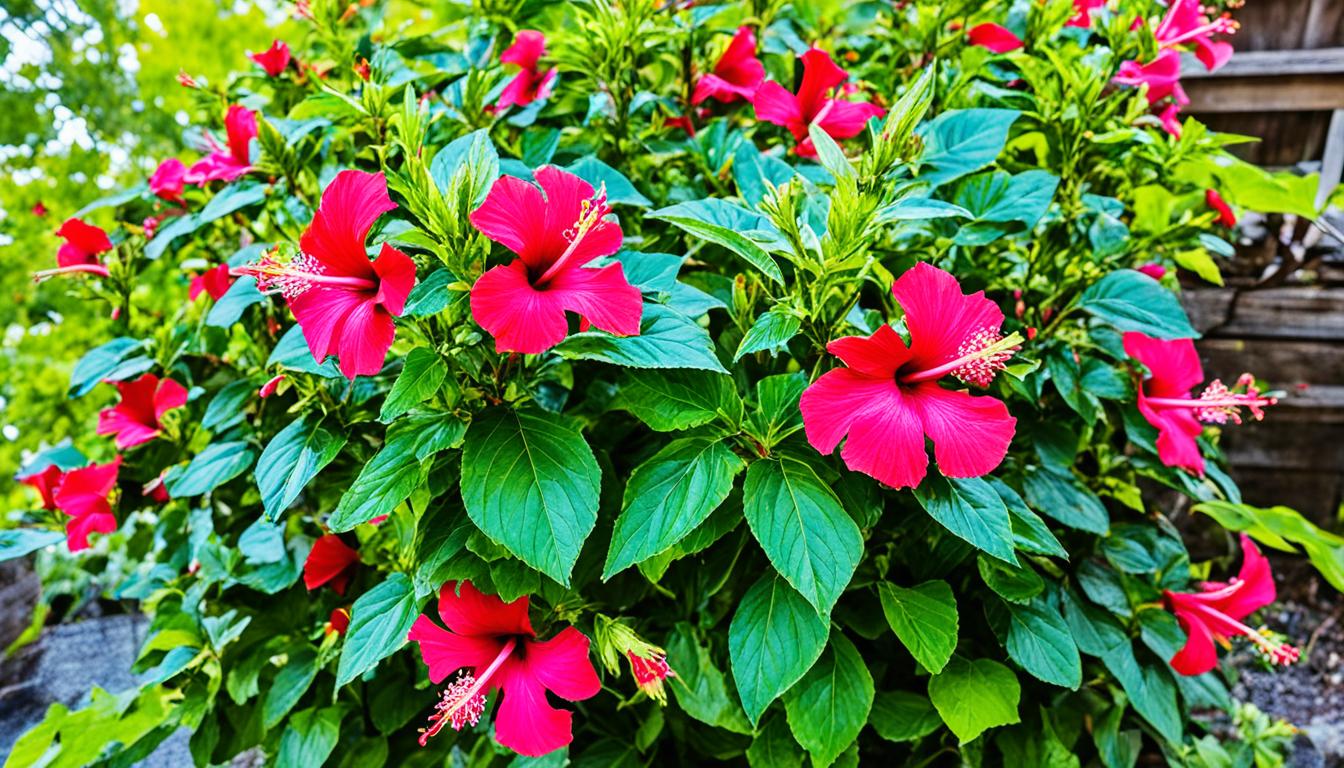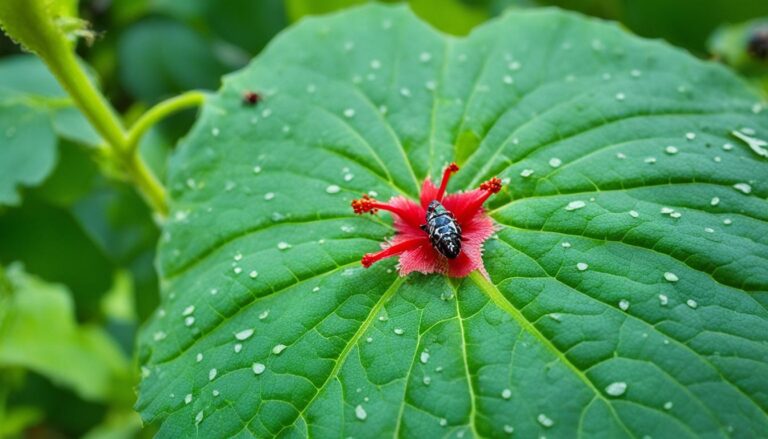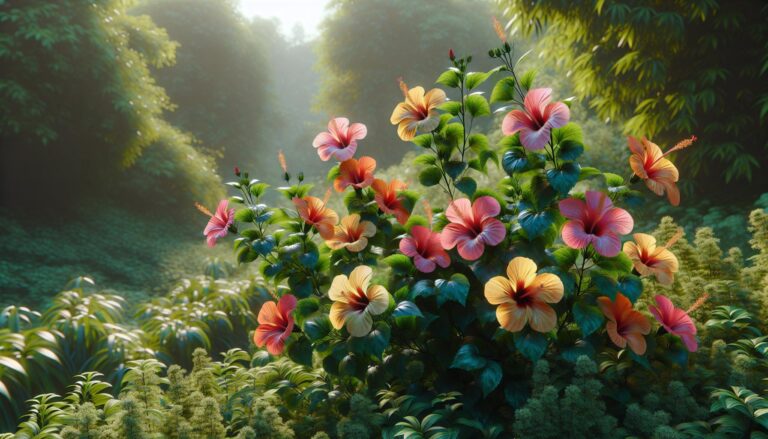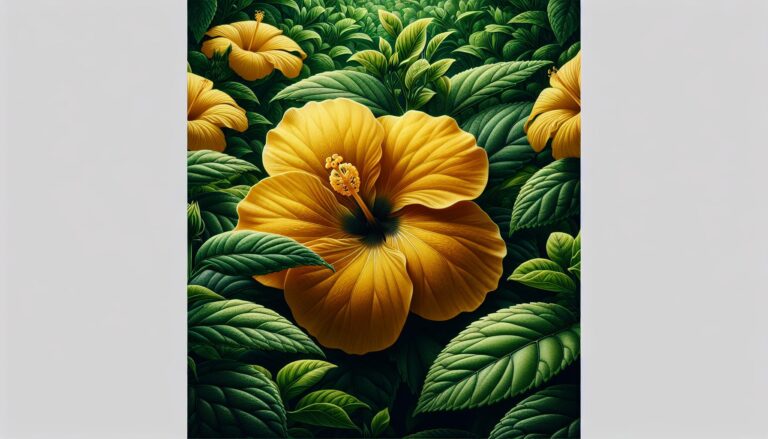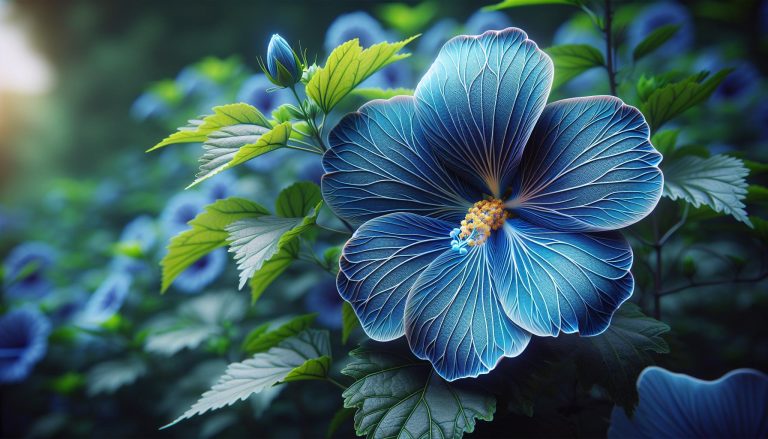Cajun Hibiscus Care Guide: Tips for Vibrant Blooms
Have you ever gazed upon the breathtaking beauty of a cajun hibiscus in full bloom? The vibrant colors and delicate petals are enough to take your breath away. It’s as if nature herself painted these magnificent flowers just for our delight.
Whenever I see a cajun hibiscus, it transports me to a place of tranquility and joy. The vibrant hues seem to dance in the sunlight, and the delicate petals invite a gentle touch. It’s a moment of pure bliss, a reminder of the incredible beauty that surrounds us.
If you’re like me and want to bring this enchanting beauty into your own garden, you’ve come to the right place. In this Cajun Hibiscus Care Guide, we will explore the secrets to cultivating vibrant blooms that will make your heart sing. From choosing the perfect location to pruning techniques, we will cover everything you need to know to ensure your cajun hibiscus flourishes.
Key Takeaways:
- Cajun hibiscus is known for its dramatic and vibrant blooms.
- Choose a sunny or partially shaded location with well-drained and acidic soil.
- Water regularly and fertilize to promote vigorous growth.
- Prune to stimulate new growth and shape the plant.
- Consider propagating from cuttings to create new plants.
Choosing the Right Location for Your Cajun Hibiscus
When it comes to cultivating healthy and vibrant Cajun hibiscus plants, choosing the right planting location is key. Whether you live in a warmer climate where they can be grown as perennials or in a colder region where container gardening is preferred, understanding their sunlight requirements is essential for their overall health and growth.
Optimal Sunlight Requirements
Cajun hibiscus plants thrive in either full sun or partial shade, depending on the climate. In northern regions, where the summers are mild, providing them with full sun exposure is ideal. On the other hand, if you reside in a hot and dry area, partial shade is recommended to prevent overheating and sunburn.
When selecting a location for your Cajun hibiscus, it is crucial to ensure that it receives a minimum of 6 hours of direct sunlight per day. This will allow the plant to harness the energy it needs for photosynthesis and promote healthy growth and blooming.
Soil Conditions
In addition to sunlight requirements, Cajun hibiscus plants also have specific soil preferences. They thrive in soils that are well-drained and slightly acidic. If your planting location has heavy clay soil, amending it with compost can help improve drainage and create a more favorable growing environment for your hibiscus plants.
Planting Location Tips
- Choose a location that provides the recommended amount of sunlight for your Cajun hibiscus plants.
- Ensure the soil is well-drained and slightly acidic.
- If planting in an area with heavy clay soil, amend it with compost for better drainage.
- Consider the mature size of the plant when determining spacing between multiple plants.
By carefully selecting the right planting location, you can create an optimal environment for your Cajun hibiscus plants to thrive. Remember to provide adequate sunlight, well-drained soil, and maintain proper spacing between plants. Doing so will ensure healthy growth and vibrant blooms that will be the envy of your garden.
| Key Points | Benefits |
|---|---|
| Choose a location with at least 6 hours of direct sunlight per day. | Promotes healthy growth and vibrant blooms. |
| Ensure the soil is well-drained and slightly acidic. | Fosters optimal root development and nutrient absorption. |
| Amend heavy clay soil with compost to improve drainage. | Prevents waterlogging and root rot. |
| Consider the mature size of the plant when spacing multiple plants. | Allows for proper airflow and prevents overcrowding. |
Watering and Fertilizing Cajun Hibiscus
Cajun hibiscus is a thirsty plant that requires consistent watering to thrive and produce vibrant blooms. To maintain the optimal moisture levels for your Cajun hibiscus, it’s essential to pay attention to the plant’s water requirements and environmental conditions.
Watering Requirements
Depending on factors such as heat, wind, and humidity, Cajun hibiscus plants may need daily or even twice-daily watering in extremely dry conditions. Aim to provide 1 to 2 inches of water per week, evenly distributed throughout the root zone. This will help the plant establish a healthy root system and facilitate nutrient uptake.
When watering your Cajun hibiscus, it is best to use a gentle stream of water to avoid damaging the plant’s flowers and foliage. Water the plant at the base, avoiding splashing water on the leaves as wet foliage can encourage fungal diseases.
Fertilizing Guidelines
In terms of fertilizing, newly purchased Cajun hibiscus plants usually have slow-release fertilizer mixed into the soil. This initial fertilizer helps provide essential nutrients during the plant’s early growth stages.
After the first few months, it is recommended to regularly fertilize your Cajun hibiscus with a diluted fish emulsion fertilizer. This type of fertilizer promotes healthy growth and encourages prolific blooming. Follow the product label instructions for the correct amount to use and the frequency of application.
When applying fertilizer, it’s important to evenly distribute it around the plant’s root zone but avoid direct contact with the foliage. Excessive fertilizer can lead to burns and damage the plant.
Key Points:
- Consistent watering is crucial for the growth and blooming of Cajun hibiscus plants.
- Aim to provide 1 to 2 inches of water per week, adjusting based on environmental conditions.
- Fertilize Cajun hibiscus with a balanced fish emulsion fertilizer after the initial few months to promote vigorous blooming.
- Follow the product label instructions for the correct amount and frequency of fertilizer application.
By following these watering and fertilizing guidelines, you can ensure that your Cajun hibiscus plants remain healthy and produce vibrant, eye-catching blooms throughout the growing season.
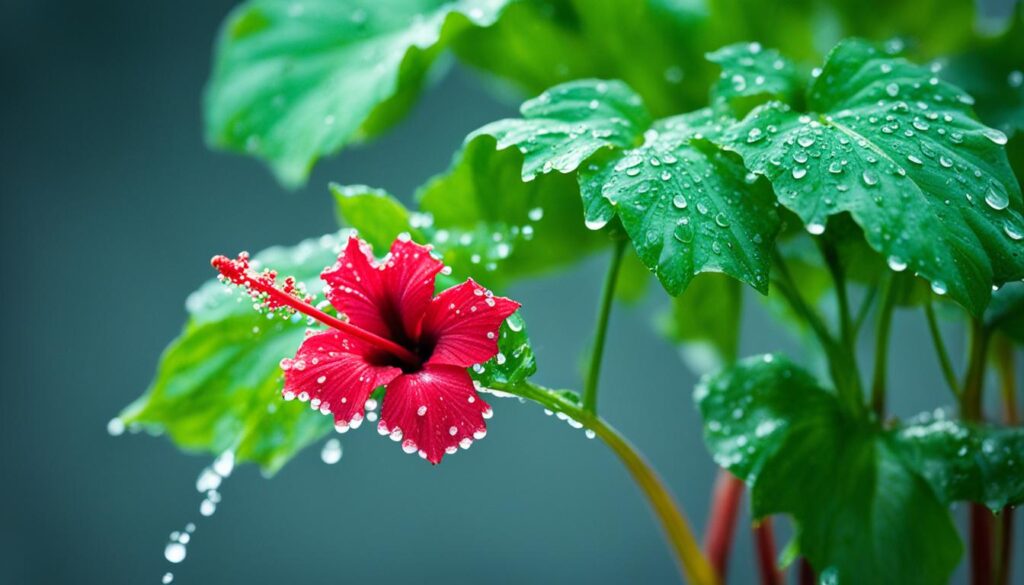
Pruning Cajun Hibiscus for Optimal Growth
Pruning plays a vital role in ensuring the optimal growth and flowering of your cajun hibiscus plants. By strategically trimming the plant at the right time, you can stimulate new growth and encourage the formation of buds and vibrant flowers. The timing of pruning depends on your location and the risk of freeze.
In areas without the threat of freezing temperatures, it is best to prune your cajun hibiscus in the fall. This allows the plant to recover from pruning and initiate new growth before the arrival of winter. On the other hand, if you live in colder regions, it is advisable to prune your cajun hibiscus in the spring when the risk of frost has passed.
During the pruning process, it is important to remove dead or diseased branches, as well as any weak or overcrowded growth. This will improve airflow and light penetration, promoting healthy growth and reducing the risk of pests and diseases. Additionally, you can shape the plant by selectively removing branches to create a more aesthetically pleasing form.
Before bringing potted cajun hibiscus plants indoors for the winter, give them a hard pruning to reduce their size and promote optimal growth when they are brought back outdoors in the spring.
By properly pruning your cajun hibiscus plants, you can ensure they have the best chance to thrive and produce abundant, colorful flowers. Remember to use clean, sharp pruning tools, and always sterilize them between cuts to prevent the spread of diseases. Whether you’re pruning to promote new growth or shape the plant, proper technique and timing are key to achieving the desired results.
In summary, pruning cajun hibiscus is essential for optimal growth and flowering. By trimming the plant in the fall or spring, you can stimulate new growth, shape the plant, and promote abundant flower production. Remember to remove dead or diseased branches and maintain good airflow and light penetration to keep your cajun hibiscus plants healthy and beautiful.
Propagating Cajun Hibiscus from Cuttings
If you want to expand your collection of Cajun hibiscus plants or share their vibrant beauty with friends and family, propagating them from cuttings is a simple and effective method. By following a few simple steps, you can create new plants that are identical to the parent plant.
To propagate Cajun hibiscus, soft-stem cuttings are typically used. This process is best done in late spring or early summer when the plant is actively growing. Choose a greenish stem that is 4 to 6 inches long, and remove all but the top set of leaves.
Tip: Select a healthy, disease-free stem for the best results.
Next, dip the end of the stem in rooting hormone to encourage root development. This step helps improve the success rate of your cuttings. Then, plant the cutting in a potting mix of well-draining soil. Ensure the soil remains evenly moist but not waterlogged.
Tip: You can use a mix of peat moss, perlite, and vermiculite for better drainage.
To create a humid environment for the cuttings, cover them with a clear plastic bag or place them in a propagator. This helps retain moisture and improves their chances of rooting. Keep the cuttings in partial shade to prevent excessive sun exposure during the rooting process.
Tip: Mist the cuttings with water occasionally to maintain the humidity level.
Over time, the cuttings will establish roots and start actively growing. This is usually indicated by new leaves appearing. Once the cuttings are well-rooted and actively growing, they can be repotted into larger containers or planted directly in the ground.
Tip: Monitor the moisture levels and provide regular care to ensure the successful growth of your new plants.
Propagating Cajun Hibiscus from Cuttings: Step-by-Step Guide
| Step | Action |
|---|---|
| 1 | Select a healthy greenish stem that is 4 to 6 inches long. Remove all but the top set of leaves. |
| 2 | Dip the end of the stem in rooting hormone. |
| 3 | Plant the cutting in a potting mix of well-draining soil. |
| 4 | Cover the cuttings with a clear plastic bag or place them in a propagator to create a humid environment. |
| 5 | Keep the cuttings in partial shade and mist them with water occasionally to maintain humidity. |
| 6 | Monitor the cuttings for new growth and roots. Once they are actively growing, repot them into larger containers or plant them in the ground. |
Propagating Cajun hibiscus from cuttings is a rewarding and cost-effective way to expand your collection. By following these simple steps, you can enjoy the beauty of these vibrant plants in your garden or share them with others.

Overwintering Cajun Hibiscus in Cold Climates
If you live in a cold climate where temperatures drop below freezing during winter, you might be wondering how to protect your Cajun hibiscus plants from the cold weather. Fortunately, with the right care and considerations, you can successfully overwinter your hibiscus indoors and ensure their survival until the warmer months return.
One of the most critical aspects of overwintering hibiscus is providing adequate light. Even during the winter months, hibiscus plants require at least 2 to 3 hours of direct sunlight daily to maintain their health. Place your hibiscus near a south-facing window or use supplemental grow lights to ensure they receive enough light.
While it’s essential to reduce watering during the winter months, it’s crucial to mist the plants daily to increase humidity. Indoor environments tend to be drier during winter, and misting the foliage can help replicate the humidity levels that hibiscus plants thrive in.
Additionally, to prevent your hibiscus from flowering during winter, which can deplete its energy reserves, remove any buds that form. This will redirect the plant’s energy towards leaf production and overall health.
In spring, when nighttime temperatures consistently stay above 50 degrees Fahrenheit, it’s time to prepare your hibiscus for the outdoor environment again. Give the plant a hard pruning, cutting it back to encourage new growth.
Once your hibiscus is pruned, gradually acclimate it to outdoor conditions by exposing it to increasing amounts of sunlight and outdoor temperatures. Start with a few hours outdoors daily and gradually increase the time until the plant can stay outside full-time.
When bringing your hibiscus indoors, be mindful of pests and diseases that may hitch a ride. Inspect the plant carefully and treat any issues promptly to prevent infestations from spreading to other houseplants.
Tips for Indoor Care:
- Provide at least 2 to 3 hours of direct sunlight daily
- Reduce watering, but mist the plant daily to increase humidity
- Remove any buds to prevent flowering during winter
- Prune in spring to encourage new growth
- Gradually acclimate the plant to outdoor conditions in spring
- Inspect for pests and diseases when bringing indoors
By following these overwintering tips and providing the necessary care, you can protect your Cajun hibiscus plants from the cold weather and enjoy their vibrant blooms for years to come.
| Key Points | Benefits |
|---|---|
| Provide adequate light | Ensure healthy growth |
| Mist the plant daily | Increase humidity levels |
| Remove buds | Redirect energy reserves |
| Prune in spring | Encourage new growth |
| Gradually acclimate to outdoor conditions | Avoid shock from temperature changes |
| Inspect for pests and diseases | Prevent infestations |
Common Pests and Diseases of Cajun Hibiscus
While generally free of pests and diseases, Cajun hibiscus can be susceptible to certain issues. It’s important to be aware of the common pests and diseases that can affect these beautiful plants and take necessary preventive measures.
Pests
Two common pests that can trouble Cajun hibiscus are spider mites and aphids. Spider mites are tiny pests that thrive in hot and dry conditions. They can cause damage by feeding on the plant sap, leading to yellowing leaves and webbing. Aphids are small insects that feed on the plant’s sap, causing stunted growth and distortion.
Controlling these pests can be done using organic methods. Neem oil is an effective natural insecticide that can be used to deter both spider mites and aphids. Applying a diluted solution of neem oil to the plant can help control infestations. Alternatively, spraying the plant with water can also help remove these pests.
Diseases
Bacterial diseases can affect Cajun hibiscus, leading to various symptoms that can adversely impact the plant’s health and appearance. Some common bacterial diseases that can affect hibiscus include:
- Leaf Wilt: A bacterial infection that causes wilting and yellowing of leaves.
- Dwarfing: Bacterial infections can stunt the growth of Cajun hibiscus plants.
- Stem Rot: Bacterial infections can cause rotting of the stems, leading to plant decline.
- Leaf Distortion: Bacterial infections can cause abnormal and distorted growth of leaves.
Preventing bacterial diseases in Cajun hibiscus involves practicing good plant care. Providing adequate air circulation around the plant can help prevent the growth and spread of bacteria. Avoiding overhead watering, which can result in moisture buildup on the leaves, is also crucial. Additionally, regular monitoring of the plant’s health and prompt action at the first sign of disease can help prevent further damage.
Pest and Disease Control for Cajun Hibiscus
Regularly inspecting your Cajun hibiscus plants for pests and diseases is essential for early detection and intervention. It’s important to take preventive measures, such as maintaining good plant hygiene, providing optimal growing conditions, and promptly addressing any issues that arise. By implementing integrated pest management techniques and practicing proper plant care, you can help ensure the health and vitality of your Cajun hibiscus plants.
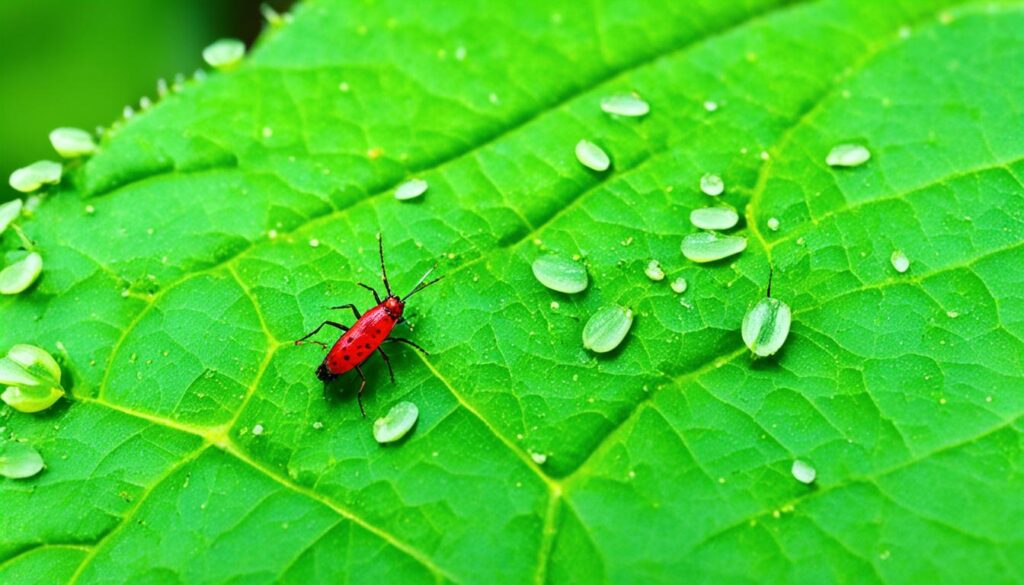
Signs of a Unhappy Cajun Hibiscus Plant
Just like any other plant, Cajun hibiscus plants can sometimes exhibit signs of distress or unhappiness. It’s essential to identify these signs early on and take appropriate measures to restore the plant’s health and vitality.
Dropping Leaves and Stressed Appearance
One noticeable sign of an unhappy Cajun hibiscus plant is the sudden dropping of leaves. If you find that your plant is losing leaves at an alarming rate, especially during periods of normal growth, it could be an indicator of underlying issues. Additionally, if the plant’s overall appearance seems stressed or lackluster, it may be struggling to thrive.
Slow Growth and Lack of Vigor
Another red flag to watch out for is slow growth and a general lack of vigor in your Cajun hibiscus plant. If you notice that the plant isn’t growing as fast as it should or the shoots and branches appear weak and feeble, it may be experiencing problems.
Yellowing Leaves and Potential Causes
Yellowing leaves can be a cause for concern and may indicate various issues affecting the Cajun hibiscus plant. Here are a few potential causes and their corresponding signs:
- Underwatering: Yellowing leaves at the top of the plant can be a sign of underwatering. Check the soil moisture level and adjust your watering routine accordingly.
- Overwatering or Nutrient Deficiency: Yellowing leaves in the middle or bottom of the plant might suggest overwatering or a nutrient deficiency. Ensure proper drainage and consider fertilizing the plant to address nutrient deficiencies.
By understanding these signs and their potential causes, you can take the necessary steps to address any underlying issues and help your Cajun hibiscus plant regain its health and vitality.
| Signs of an Unhappy Cajun Hibiscus Plant | Possible Causes |
|---|---|
| Dropping leaves | Underlying issues affecting the plant’s health and vitality |
| Stressed appearance | Environmental factors such as prolonged heat or lack of proper care |
| Slow growth and lack of vigor | Inadequate growing conditions or underlying health problems |
| Yellowing leaves | Underwatering, overwatering, or nutrient deficiencies |
Introducing Beau Peep Cajun Hibiscus
Beau Peep Cajun Hibiscus is a stunning flowering shrub that will add a vibrant touch to your Lafayette, LA garden. This unique variety is known for its trumpet-shaped blooms, featuring a wide range of mesmerizing colors and intricate patterns. Whether you prefer shades of red, pink, orange, or yellow, Beau Peep Cajun Hibiscus has it all.
One of the standout features of this flowering shrub is its compact growth habit. With an average height of 3 to 4 feet, it is perfect for small gardens and can also be planted in containers or showcased as a focal point in landscape beds.
Designed specifically for the Cajun region, Beau Peep Cajun Hibiscus thrives in Lafayette’s hot and humid climate. It is well-suited to the local environment, making it an ideal choice for your garden. The vibrant blooms will surely catch the eye and create a stunning visual display.
With its captivating flowers and compact growth, Beau Peep Cajun Hibiscus is a must-have for any Lafayette, LA garden. Create a vibrant and picturesque landscape with this beautiful flowering shrub.
Characteristics and Care of Beau Peep Cajun Hibiscus
Beau Peep Cajun Hibiscus is a stunning variety that produces striking, multicolored flowers in shades of red, pink, orange, and yellow. These vibrant blooms feature intricate patterns and markings, creating a visually captivating display in any garden or container.
One of the standout characteristics of Beau Peep Cajun Hibiscus is its compact growth habit. This makes it an ideal choice for small gardens or containers, where space may be limited. Despite its compact size, this variety still produces abundant blooms that will brighten up any landscape.
This Cajun hibiscus variety is well-suited to the hot and humid climate of Lafayette, LA. It can tolerate both full sun and partial shade, giving gardeners flexibility when choosing its planting location. Whether placed in a sunny spot or a slightly shaded area, Beau Peep Cajun Hibiscus will thrive and continue to produce its stunning flowers.
Proper care is essential for the health and longevity of Beau Peep Cajun Hibiscus. Start by planting it in well-draining soil that is enriched with organic matter. This will ensure that the roots have access to the necessary nutrients and moisture without becoming waterlogged. Regular watering is crucial to keep the plant hydrated, but be careful not to overwater, as this can lead to root rot.
Additionally, balanced fertilization is important for the overall health and blooming performance of Beau Peep Cajun Hibiscus. Applying a slow-release fertilizer in early spring and mid-summer will provide the plant with the necessary nutrients to support its growth and vibrant blooms.
To maintain the shape and overall health of the plant, pruning can be done in late winter or early spring. Remove any dead or damaged branches to stimulate new growth and ensure optimal flowering.
Beau Peep Cajun Hibiscus Care Summary:
- Plant in well-draining soil enriched with organic matter
- Provide regular watering, ensuring the soil is moist but not waterlogged
- Choose a location with full sun or partial shade
- Apply a slow-release fertilizer in early spring and mid-summer
- Prune in late winter or early spring to remove dead or damaged branches
| Characteristics | Care Tips |
|---|---|
| Produces multicolored flowers in shades of red, pink, orange, and yellow | Plant in well-draining soil enriched with organic matter |
| Compact growth habit, ideal for small gardens and containers | Provide regular watering, avoiding overwatering |
| Tolerates full sun or partial shade | Choose a location with adequate sunlight |
| Thrives in Lafayette, LA’s hot and humid climate | Apply a slow-release fertilizer in early spring and mid-summer |
| Prune in late winter or early spring to remove dead or damaged branches |
Planting and Care Tips for Beau Peep Cajun Hibiscus
When planting Beau Peep Cajun Hibiscus in Lafayette, LA, it’s important to consider the specific needs of this vibrant flowering shrub. By following these planting and care tips, you can ensure your Beau Peep Cajun Hibiscus thrives and adds beauty to your garden.
Choosing the Right Location
Beau Peep Cajun Hibiscus requires a location that receives at least six hours of direct sunlight per day. This will help the plant to grow and produce vibrant blooms. Select an area with well-draining soil that is slightly acidic to neutral. This type of soil will provide the necessary nutrients and promote healthy growth.
Regular Watering
Watering is crucial for the health of your Beau Peep Cajun Hibiscus. It’s important to keep the soil consistently moist but avoid overwatering. Allow the top layer of soil to slightly dry out between watering sessions to prevent waterlogging. This will help the roots to establish and ensure the plant’s overall health.
Mulching for Moisture and Weed Control
To conserve moisture and suppress weed growth, apply a layer of organic mulch around the base of the Beau Peep Cajun Hibiscus plant. Mulching also helps to regulate soil temperature and improves overall soil quality. Be sure to leave a small gap around the stem to prevent moisture buildup and potential stem rot.
Pruning in Late Winter or Early Spring
Pruning should be done in late winter or early spring to remove any dead or damaged branches and to shape the plant. This helps to promote healthy growth and maintain a desired shape. Additionally, pruning improves air circulation and light penetration, which can prevent pest and disease issues.
Fertilizing with a Balanced Slow-Release Fertilizer
Beau Peep Cajun Hibiscus benefits from regular fertilization to ensure optimal growth and vibrant blooms. Apply a balanced slow-release fertilizer in early spring and mid-summer according to the package instructions. This will provide the necessary nutrients for the plant to thrive throughout the growing season.
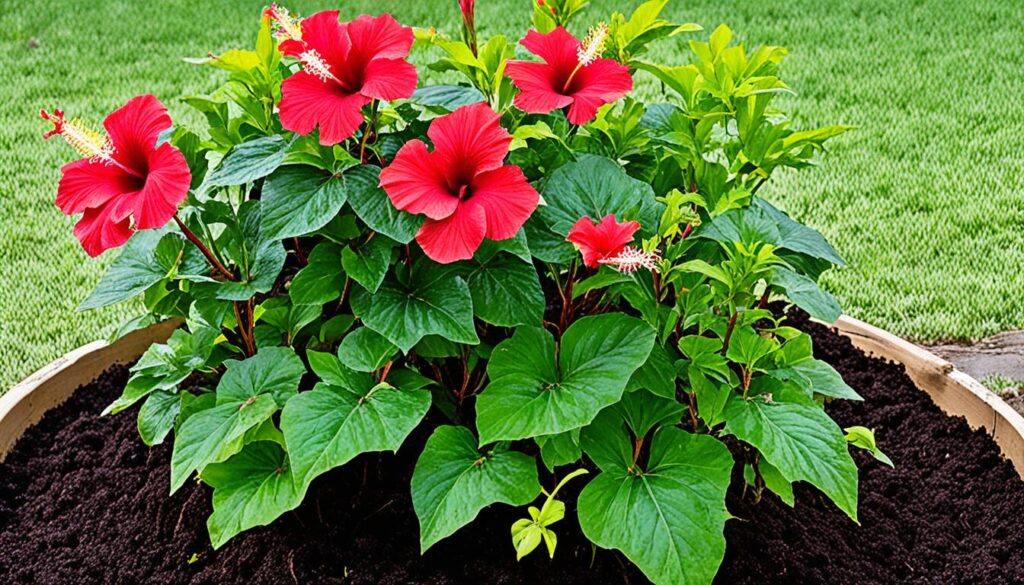
Cane Row Nursery and Landscaping: Your Source for Cajun Hibiscus
If you’re looking for top-quality Cajun hibiscus plants in Lafayette, LA, look no further than Cane Row Nursery and Landscaping. We are your one-stop destination for all your Cajun hibiscus needs, offering a wide selection of plants in various colors and varieties.
At Cane Row Nursery and Landscaping, we take pride in providing the highest quality plants to our customers. Our Cajun hibiscus plants are carefully cultivated to ensure vibrant blooms and healthy growth. Whether you’re looking for vibrant reds, pinks, oranges, yellows, or purples, we have a color to suit every taste.
Not only do we offer a wide selection of Cajun hibiscus plants, but we also provide landscaping services for both residential and commercial clients. Our skilled team can help design and install breathtaking landscapes tailored to your preferences. Whether you’re looking to create a serene backyard oasis or enhance the curb appeal of your commercial property, we have the expertise to bring your vision to life.
Backed by our commitment to customer satisfaction, we strive to provide exceptional service and high-quality products every step of the way. We believe that gardening and landscaping should be enjoyable experiences, and we’re here to make that happen for you.
Why Choose Cane Row Nursery and Landscaping?
- Wide selection of top-quality Cajun hibiscus plants
- Expert landscaping services for residential and commercial clients
- Experienced and knowledgeable team
- Commitment to customer satisfaction
Visit Cane Row Nursery and Landscaping today to explore our selection of Cajun hibiscus plants and let us help you create the perfect garden or landscape. We’re here to make your gardening dreams come true.
| Cane Row Nursery and Landscaping | Contact Information |
|---|---|
| Address: 123 Main St, Lafayette, LA | Phone: (123) 456-7890 |
| Email: info@canerownursery.com | Website: www.canerownursery.com |
Cajun Hibiscus Container Planting Tips
When it comes to planting Cajun hibiscus in containers, there are a few key considerations to keep in mind. By following these tips, you can ensure that your container-grown hibiscus thrives and produces beautiful blooms.
Choosing the Right Potting Mix
Start by selecting a high-quality potting mix that is specifically formulated for tropical plants. Look for a mix that provides good drainage while also retaining moisture. This will help prevent waterlogged roots and promote healthy growth.
Optimal Container Shape and Size
The shape and size of the container you choose can impact the growth and flowering of your Cajun hibiscus. Opt for a relatively shallow pot with several draining holes to allow excess water to escape. Avoid very deep containers, as they can encourage excessive root growth at the expense of flowering.
Unglazed clay pots are an excellent option for container planting. Their porous nature allows for better airflow and water drainage, preventing root rot and other issues.
Repotting and Nutrient Renewal
To ensure sufficient nutrition for your container-grown Cajun hibiscus, it’s important to repot the plant every one to two years. This gives the plant fresh soil and replenishes the nutrients it needs to thrive. When repotting, choose a container that is slightly larger than the existing one to allow for root growth.
Remember to use the same potting mix as mentioned earlier to provide optimal growing conditions for your Cajun hibiscus.
Proper Watering and Care
Container-grown plants require more frequent watering compared to those planted directly in the ground. Check the moisture level of the soil regularly and water whenever the top inch feels dry. Make sure to water thoroughly, allowing excess water to drain out of the bottom of the pot.
In addition to watering, provide your Cajun hibiscus with adequate sunlight, as it is a sun-loving plant. Aim for at least 6 hours of direct sunlight per day, placing the container in a sunny spot or using supplemental grow lights indoors.
Fertilize your container-grown Cajun hibiscus regularly with a balanced slow-release fertilizer to ensure it receives the necessary nutrients for robust growth and abundant flowering.
By following these container planting tips, you can enjoy the beauty of Cajun hibiscus in your patio, balcony, or indoor spaces. With the right potting mix, container shape, and proper care, your container-grown Cajun hibiscus will thrive and bring vibrant color to your surroundings.
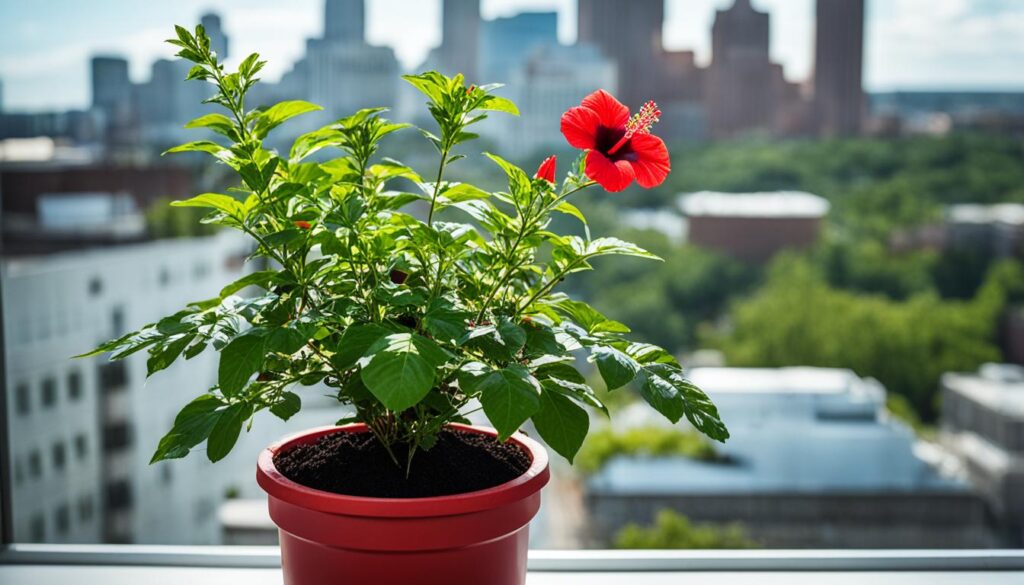
Proper Spacing and Sizing for Cajun Hibiscus Plantings
When it comes to planting Cajun hibiscus, proper spacing and sizing are important considerations to ensure healthy plant growth and vibrant blooms. Cajun hibiscus plants can reach a mature height of 2 to 4 feet and a spread of 2 to 4 feet.
To allow for adequate growth and proper airflow, it is recommended to space multiple Cajun hibiscus plants approximately 3 feet apart, measured from the center of each plant. This spacing allows the plants to flourish without crowding each other and promotes optimal plant health.
When planning the spacing for your Cajun hibiscus, it’s important to consider the plant’s mature size and the desired arrangement. By allowing enough space between plants, you give them room to grow and thrive.
If you choose to grow Cajun hibiscus in containers, it’s essential to select the right-sized pot. A container with a diameter of at least 10 inches will accommodate the plant’s growth and provide enough space for the roots to develop.
Proper spacing and sizing are vital for Cajun hibiscus plantings, whether in the ground or in containers. By following these guidelines, you can create an aesthetically pleasing arrangement and ensure the health and vitality of your Cajun hibiscus plants.
Cajun™ Bienvenue Tropical Hibiscus: Characteristics and Care
The Cajun™ Bienvenue Tropical Hibiscus is a stunning flowering shrub that will add a touch of tropical beauty to your garden. With its bi-color blooms reminiscent of a sunset, this hibiscus variety is sure to catch the eye of any passerby. The flowers start with deep pink centers, gradually fading to salmon, and finally turning bright yellowish-orange along the ruffled edges. This stunning color progression creates a visual masterpiece that continuously blooms throughout the growing season, ensuring your garden is always alive with vibrant colors.
Standing at a height of 2 to 4 feet, the Cajun™ Bienvenue Tropical Hibiscus is the perfect size to fit into any garden or landscaping project. Its compact growth habit allows it to thrive in both full sun and partial shade, making it a versatile choice for any area. Whether you have a sunny spot in your garden or a partially shaded patio, this hibiscus variety will flourish and provide you with a stunning display of flowers.
To ensure the health and vitality of your Cajun™ Bienvenue Tropical Hibiscus, it’s important to provide it with the right care. Start by planting it in well-draining soil that is enriched with organic matter. This will help provide the plant with the proper nutrition and moisture balance it needs to thrive. Regular watering is essential, especially during dry periods, to keep the soil moist but not waterlogged.
In terms of fertilization, weekly applications of a balanced, water-soluble fertilizer will help promote healthy growth and abundant flowering. Apply the fertilizer according to the package instructions, ensuring you do not over-fertilize the plant. A balanced fertilizer with equal amounts of nitrogen, phosphorus, and potassium is ideal for supporting overall plant health.
With its stunning bi-color blooms and compact growth habit, the Cajun™ Bienvenue Tropical Hibiscus is a must-have for any garden enthusiast. Its ability to thrive in both full sun and partial shade makes it a versatile option for any landscape. By providing it with well-draining soil, regular watering, and weekly fertilization, you can ensure that this tropical beauty will grace your garden with its vibrant colors for years to come.
Key points at a glance:
- Bi-color blooms reminiscent of a sunset
- Flowers start with deep pink centers, fading to salmon and then bright yellowish-orange edges
- Continuous flowering throughout the growing season
- Compact growth habit, reaching a height of 2 to 4 feet
- Thrives in full sun and partial shade
- Plant in well-draining soil enriched with organic matter
- Water regularly to keep the soil moist
- Apply a balanced, water-soluble fertilizer weekly
Conclusion
Cajun hibiscus plants are a true delight for any garden enthusiast. With their vibrant blooms and compact growth habit, these plants add a pop of color and beauty to any landscape. By following the care tips and guidelines provided, including proper watering, fertilization, and pruning, you can ensure that your cajun hibiscus thrives and produces stunning, vibrant blooms.
Whether you choose to plant your cajun hibiscus in the ground or in containers, there are various varieties to choose from. Beau Peep and Cajun™ Bienvenue are just a couple of the options available, each offering their own unique colors and patterns to enhance your garden. For a wide selection of cajun hibiscus plants, look no further than reputable nurseries like Cane Row Nursery and Landscaping.
So why wait? Elevate the beauty of your garden with these stunning cajun hibiscus plants. With the right care and attention, you can enjoy vibrant blooms and create a truly breathtaking space. Start incorporating these vibrant varieties into your garden today and watch as they bring life and color to your outdoor oasis.

